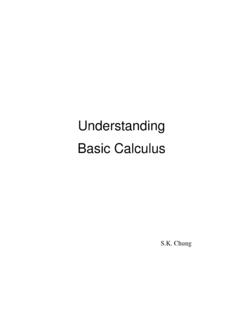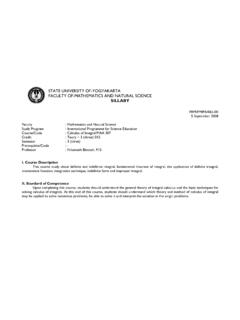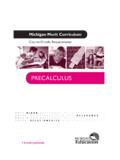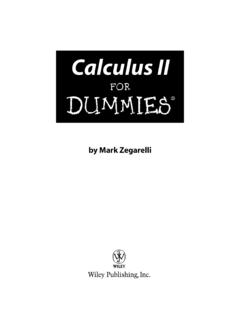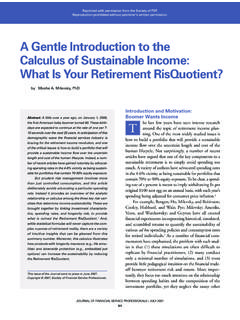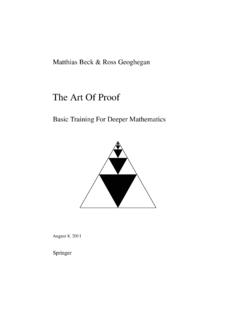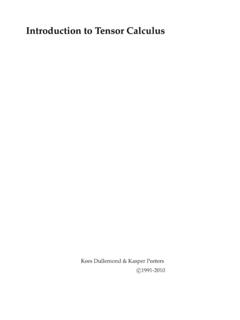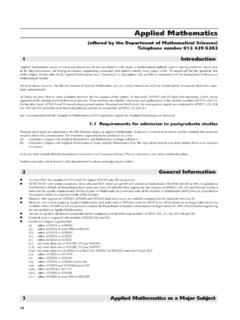Transcription of free physics notes for basic physics - Fearofphysics
1 free physics notes for basic physics1 Preliminaries: Things you have to knowHere are some preliminaries for this course. These are things that should be automatic to don t really have anything to do with physics , and aren t necessarily something you ll learnin physics , but should already know from your preparation to be entering this technical what a right triangle is and how sin, cos, and tan work with thatright triangle. Know how the pythagorean theorem works with a right that sin 0 = 0 , cos 0 = 1, sin 90 = 1 and cos 90 = the difference between a radian and degree and how to interconvertbetween a functiony(x), know how to finddy/dxandd2y/dx2.
2 As an alternativenotation, giveny(x), know how to findy (x) andy (x).Vectors or physics we often draw arrows on objects to indicate that something ishappening to it. The arrow is also called a vector and it ll be labeled with some quantity,likeFfor force orvfor velocity, etc. For example if you see a ball with an arrow pointingup and to the right, and the arrow is labeledv, you might be able to conclude that the ballis moving in that often need to be described in words. Know what it means for avector to point at 30 with the +x-axis, 16 north of east, or south east. Operation on Vectors (1).
3 If you have a vector, no matter what direction it is pointing, youshould be able to find itsxandycomponents. This is most easily done by drawing asmallxy-coordinate system at the tail of the arrow. Next, treat the vector itself like thehypotenuse of a right triangle and draw in the legs, one along thexaxis and the otheralong theyaxis of your little coordinate system. Label in some angle and use sine andcosine as needed to find the lengths of thexandycomponents (the legs).Operation on Vectors(2).If you have thexandycomponents of a vector, you should beable to draw the vector itself and determine the angle the vector makes with respect to thex-axis.
4 This is all done with basic trigonometry. Invariably this will involve using tan 1somewhere. You should also know how to find the magnitude of a vector, which comesfrom the Pythagorean Theorm; if you know the legs of a right triangle (the components),you should be able to find the hypotenuse (or the magnitude of the vector).Handling are many ways of representing vectors; here are the most common. Magnitude and angle. Specify the magnitude (strength, length, etc.) and the 10 m/s at 45 up from the +x-axis. i, j, k-notation (or engineering notation). Specify the components of the vector di-rectly.
5 Istands forx, jstands foryand kstands forz. In this class thez-componentwill always be zero. So a vector written like 5 i+ 2 jmeans a vector that has a strengthof 5 units in thex-direction and 2 units in they-direction. You should be able to findthe magnitude and angle of this vector (if needed) directly from the 5 and the Ordered set notation.< x,y,z >wherex,y, andzare the components of the vector,so<5,2,0>would be the same as the vector are letters that stand for numerical values. Something likex2means thatisxis known, we should multiply it by itself. On paper, we could writex= 4, thenknow thatx2will evaluate to , calculators, and spreadsheetsbehave in thesame manner; textual variables can hold values for later use.
6 So on a computer we couldtypex=5assigning the value of 5 to variablex. Variable names on computer are oftenlonger, to make them more descriptive. So instead ofxwe might seespherex, meaningthe x-coordinate of the sphere. In a spreadsheet (like Excel) the variable name might besomething likeA9, representing the cell at columnA, in mathematics, you should be familiar with the use of a example if you know thatf(x) =x2, then you are free tousethe function. You candifferentiate it:f (x) = 2x. You can evaluate it atx= 5, orf(5) to get 25. Functionscan also have different names, likeg, and be functions of more than one variable, likeg(x,y,t) =x2+y2 t2for on your graphing calculator or a computer, calculators, or spread-sheetsthere are also functions, but instead of just returning a number, likesin(x)a func-tion on a computer can cause something to happen, like to color the screen or draw a names on a computer are typically longer than justforg, such functions often have parameters too, in the same format as their mathematicalcounterparts, as innamethenparenthesized list of parameters.
7 So instead off(x,y), we dhavedrawvector(tip,tail,color,label)whe retipandtailare the tip and tail coordinates ofa vector to draw, with a color ofcolorand a label oflabel. Calling this function doesn treturn a number; it draws a vector on the : More than magnitude and direction When asked, most students will say that a vector is a quantity with a magnitude and direction. There is much more to vectors than this textbook meaning, and the sooner you become friends with vectors, the easier time you re going to have in your core math and science start, think of a vector as a container for information about an object.
8 To emphasizethe container aspect, we ll write vectors enclosed in a<and>, or the ordered set notation(see above). As an example, an object might be located atx= 5,y= 3, andz= 1. In vectorform, this would be written as~r=<5,3, 1>, or pos=<5,3, 1>. In both cases, the 5, 3,and 1 are called the components (or parts) of the vector. The arrow over the symbol meansit s a vector (it has the three components). Notice how compact the vector is as a look at<5,3, 1>and you can immediately see thex,y, andzposition of an velocity vector can be stated in the same manner. Suppose an object has anx-velocity of6 m/s and ay-velocity of 2 m/s.
9 It s v-vector could be written as~v=<6,2,0>, or speed=<6,2,0>. Acceleration vectors can be written similarly. For example, an object in free fall has~a=<0, ,0>.The real convenience of vectors is in their algebraic operations. For example, a vector canbe multiplied by a scalar, by simply multiplying all of its components by the scalar. So, 5 <6,2,0>=<30,10,0>. This is useful in the physics equationsv=v0+a tandx=x0+v0 t+12a t2, Because tis always a scalar (a time interval), but in these equations it s multiplied byeitheraorv0, which can be vectors. This means that ana-vector of<0, ,0>times a tof2 seconds would be<0, ,0> 2 or<0, ,0>.
10 But sincev=a t, the<0, ,0>is the object s a complete example, suppose~v0=<2,1,0>and~a=<0, ,0>. If you wish toknow the object s new velocity after 2 seconds has gone by, you can use~v=~v0+~a t, or~v=<2,1,0>+<0, ,0> 2. Working this, we ll get~v=<2,1,0>+<0, ,0>or~v=<2, ,0>. In other words, after 2 seconds, the object is moving 2 m/s along thex-axis, m/s along the y-axis, and it is not moving at all along Common Stuff: your magnitude and direction The notation< x,y,z >is a very succinct vector of the common vector stuff can befound by simply using the information in such a vector.
